The latest version of Dungeons and Dragons, 5th edition (D&D 5e) has received much praise for its inclusivity of race, sexuality and gender.1 Yet D&D 5e appears less inclusive when it comes to its representation of disability. Although Wizards of the Coast, the parent company that produces D&D, has made efforts towards inclusivity, the game still suffers from an inherent sense of ableism. Ableism assumes that everyone is able-bodied and constitutes an approach to the world (albeit a fantastical one) that rewards only those who are able-bodied. Disability scholars such as Elsa Henry often focus their discussions on addressing the physical accommodations of disabled players.2 Through a close reading of the D&D source books, however, I show how the texts subtly promote ableism through the game mechanics of Conditions and the Madness Table, the stereotypical treatment of disabled NPCs non-player characters in various modules, and the lack of visual representation in the Player’s Handbook (PHB)3 and Dungeon Master’s Guide (DMG).4 Ultimately, there is a need for more positive portrayals of disabilities beyond stereotypes and mere narrative detail.
While some may argue that D&D is meant to be escapist, fantastical fun that should not be realistic, it is important to consider that other realistic aspects of life (gender, race, sexuality, socio-economic status, etc.) have been incorporated into the game. So why not disability? The easy answer is that players are meant to play super-heroic characters, who are physically and mentally capable of defeating their enemies. Characters level up and continue to excel, growing ever stronger, faster, and “better”. D&D is, of course, not the only RPG that promotes this kind of Darwinian framework: D&D-inspired games such as Lamentations of the Flame Princess,5 Dungeon Crawl Classics,6 and Torchbearer7 all exhibit this kind of extremity of fantasy that suggests only the strongest deserve to survive. But as Henry points out, “opening up the possibilities to what some might consider imperfections creates new avenues to new stories that haven’t been told before.”8 If D&D and other RPGs are ultimately about storytelling, why exclude this concept from our stories?
By denying a player the opportunity to create a character that reflects their own identity and reality, D&D and other RPGs with similar mechanics limit disabled gamers’ ability to witness and identify with their characters while simultaneously perpetuating a sense of ableism among non-disabled players. Henry argues, “games such as Dungeons & Dragons need inclusion not just because people with disabilities play those kind of games, but because without the presence of characters with disabilities we forget they exist in the worlds we create.”9 This is not to suggest that all disabled gamers will want to play a disabled character just as not all female gamers want to play a female character or all gay players want to play gay characters. But the point of the matter is: the option for female and gay characters exists in D&D and is even, in 5e, encouraged by the game instructional materials. This is less so for disabled players and characters. A player should be allowed to build their character however they so choose – including willingly creating a character with these disabilities that might better reflect themselves, their world, or at least their character. There is a need for a positive portrayal of disabilities: not one that is stereotypical or only a narrative detail. Unfortunately, D&D 5e does not fulfill this need.
Conditions
Appendix A in the Player’s Handbook lists out “conditions” that “alter a creature’s capabilities in a variety of ways and can arise as a result of a spell, a class feature, a monster’s attack or other effect.”10 Specifically, the PHB states that most of the conditions “such as blinded, are impairments, but a few, such as invisible, can be advantageous.”11 Thus many of the conditions, both physical and mental, are treated and viewed as punishments, banes that the Dungeon Master or the game itself inflict upon the characters. Some examples of conditions are blinded, deafened, charmed, frightened, invisible, paralyzed, poisoned, and prone. The conditions then are a conglomeration of actual physical disabilities mixed with (and equated to) magical or psychological states. Deafness, a condition that a player at the table might actually have, is equated to something like being magically charmed by a sexy nymph or being knocked on one’s butt for a round.
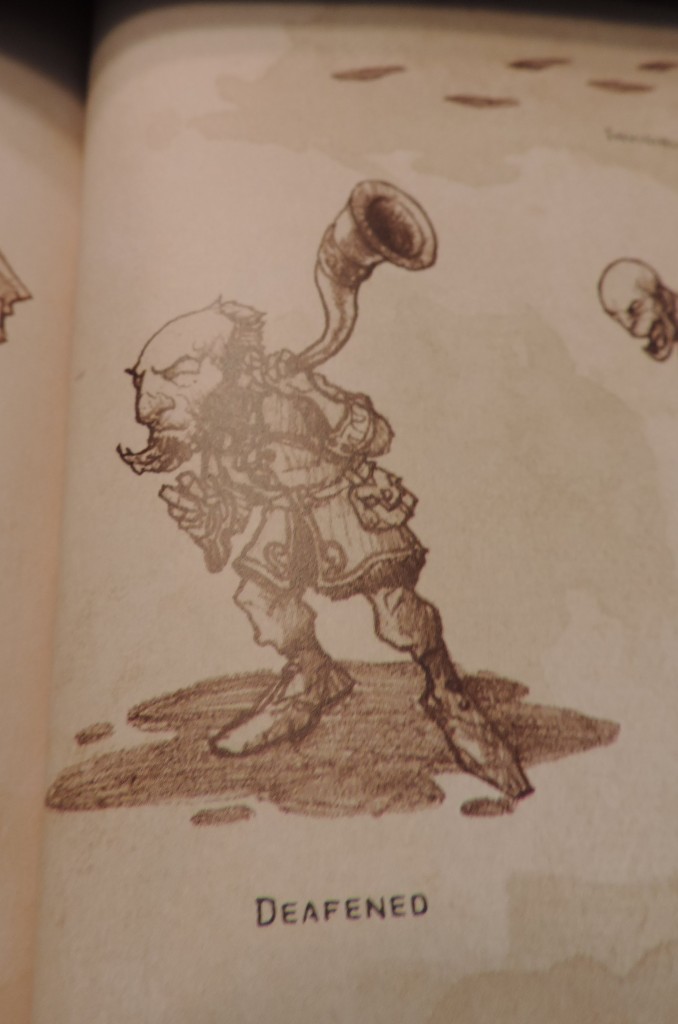
Furthermore, the imagery used to depict these conditions is reductive and relies upon stereotypes. For the “deafened” condition we see an old man with a horn to his ear, a clichéd image that reduces deafness to an age-related condition. Similarly, blindness is portrayed by a male dwarf wearing a blindfold and trying to take a tentative step. This imagery reinforces the inherent ableism by suggesting these conditions are something to suffer from and overcome or beat and that they are a burden limiting ordinary life.
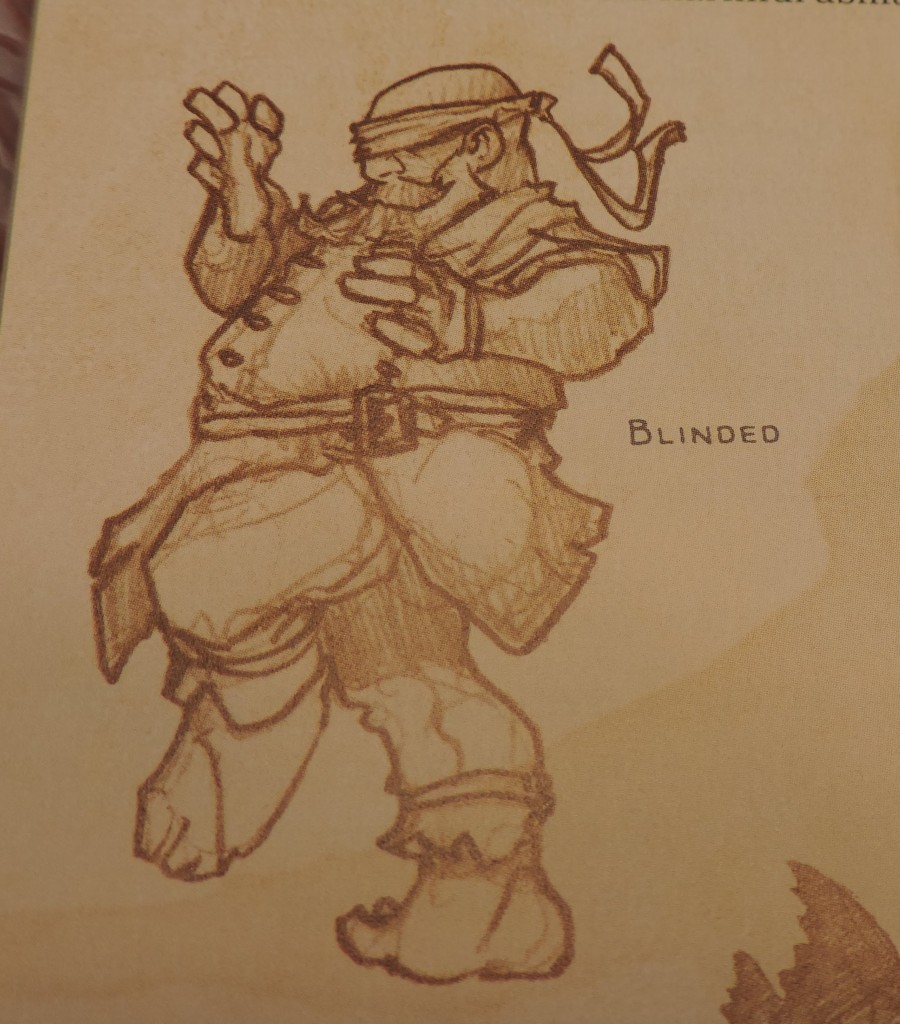
Conditions such as blindness or paralysis would certainly affect a fighter’s or wizard’s capabilities. But these negative portrayals of blindness, deafness, and paralysis should not be the only portrayals available to a player character. D&D must move beyond the ableism that portrays disabilities as inherently negative, punishing, disabling features. Of course blindness will affect a fighter’s aim, but if a player wishes to play a blind wizard or a ranger who is hard of hearing (which might affect her tracking ability and she’ll have to use other creative resources to track creatures) there are limited (if any) mechanics available to that player. And while nothing necessarily prevents or precludes players from “going off script” as it were and role-playing their character as they like,the handbook feels restrictive by not including examples or mentioning such role-play as a possibility.
Madness Table
Located in the DMG, the problematically named “Madness Table” castigates mental disabilities as “craziness” and as a penalizing, magical effect rather than an actual condition. By sequestering this information in the DMG, we see two effects: 1) it precludes players from incorporating those aspects into their characters as they build them, reiterating that it is the DM’s purview to allow characters to have these features; and 2) by having the DM control these characteristics, it feels punitive; the character (or player) is being “punished” by receiving a negative characteristic off the madness table.
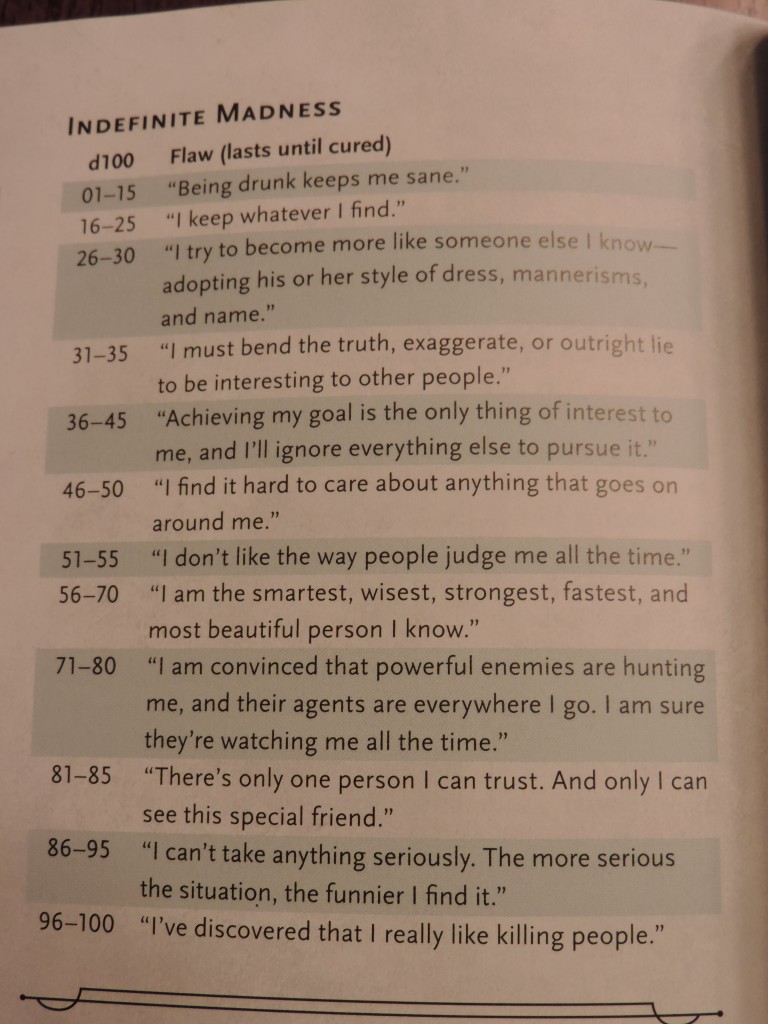
Moreover, the Madness table comes in multiple variations: there is short-term madness, long-term madness, and indefinite madness. Once again, this serves to provide a limited and inaccurate representation of disability. For example, blindness, deafness, and muteness are all conditions listed on the “long-term” (meaning 10 hours to 4 days) as opposed to being listed on the “indefinite” Madness table. Additionally, the Madness tables lump together psychological and physical conditions. In this hodgepodge of traits, psychopathy is likened to mutism, which is likened to alcoholism or apathy, which is likened to having a good luck charm or partial memory loss or narcissism or kleptomania. It is an unruly lumping of “bad” things that only serves to punish characters. It also encourages players to view these effects as negative and temporary as opposed to being parts of their character’s identity and embrace these differences in a meaningful way either through role-play or game mechanics. “Madness” then is simply a punitive effect that can be rolled away, waited out, or magically undone.
NPCs and Disabilities
Looking closer at some of the official modules, or pre-written adventures, for D&D 5e, we see that very few main NPCs are portrayed as having any kind of disabilities. When they are portrayed, they are stereotypical or token representations. According to Biklen and Bogdan,12 two professors of education who study the representation of disabilities in media, there are 10 stereotypical portrayals of disabled characters: 1) the pitiable and pathetic character ala Tiny Tim; 2) the object or victim of violence; 3) an evil figure like Captain Ahab; 4) atmospheric or background figures; 5) the “super crip” who has so overcompensated for their disability they are super-human in some way; 6) laughable like Mr. Magoo; 7) his or her own worst enemy; 8) a burden who is helpless and reliant upon others; 9) nonsexual; and 10) incapable of fully participating in everyday life. An eleventh stereotype has been developed by more modern theorists that sees a “person with a disability as being isolated from disabled and non-disabled peers.”13
Of these common stereotypical portrayals of disabled individuals, in many of the official adventure modules published by Wizards of the Coast, we see disabled NPCs who particularly fit the “evil” stereotype (they literally have an “evil” alignment), or the “supercrip” model. Countless villains fall into the “crazy therefore evil” (or “evil therefore crazy”) category, including many of the enemies in Out of the Abyss (e.g. the Derro, Narrak, the Pudding King, etc.).
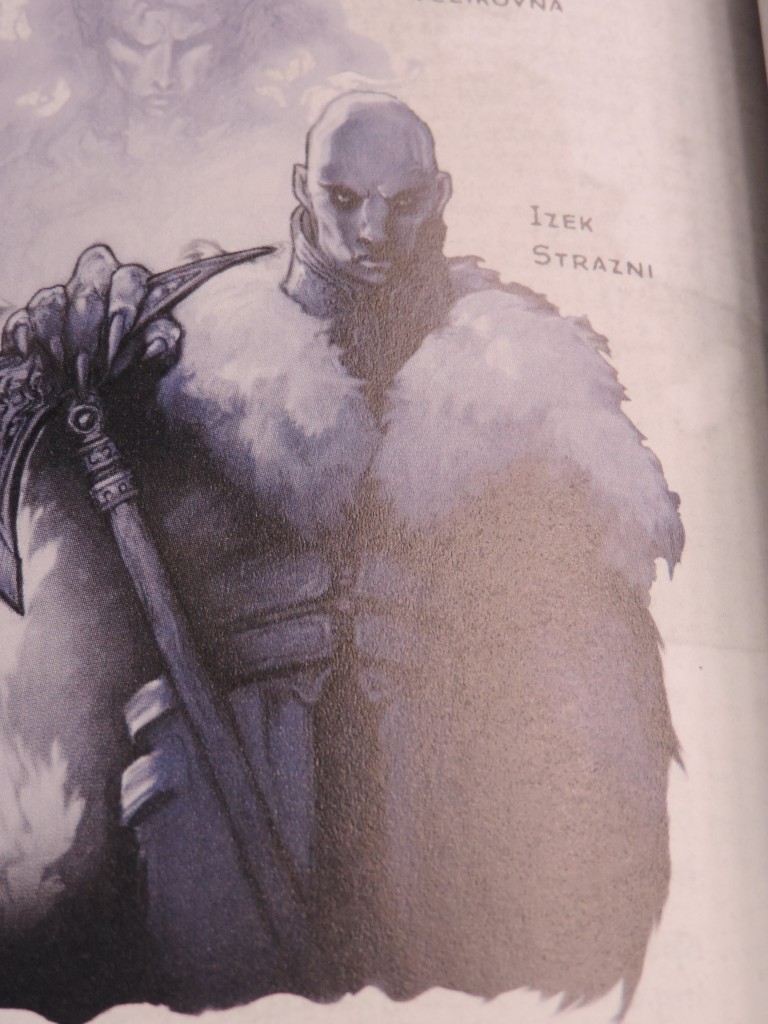
More specifically, Izek, an evil NPC in the Curse of Strahd module, is a “sociopath”14 whose arm was bitten off by a wolf. We learn from Izek’s brief bio that he “learned to cope with his disability”15 and that, after his parents died and he was mocked by other children, he killed his enemies and hid the evidence. Eventually, Izek awoke one morning to find he had grown a fiendish arm––with barbed spines, long fingers and nails––that can create fire. Izek’s traumatic story is underpinned with the ableistic notion that he can only be powerful if he overcomes his disability. Moreover, by portraying the one-armed figure as a sociopathic monster, the text reiterates the stereotypes of disabled individuals as evil and incompatible to a healthy, productive society.
Similarly, in the module Princes of the Apocalypse16 we have Hellenrae, a blind lawful evil monk who uses her “heightened” other senses, a la the comic book superhero Daredevil, to overpower her enemies. Hellenrae has been blind since she was a child, which made her bitter and angry. The monks took her in and trained her “to use her other senses to compensate,”17 molding her into an evil “supercrip.” She is portrayed as dour, drab, and remote: she hates weakness and, therefore, everyone. She prefers to be alone and has no interest in the typical day to day activities of her other Black Earth cultists, isolating herself physically and symbolically by wearing a “golden gargoyle mask with no eye holes.”18
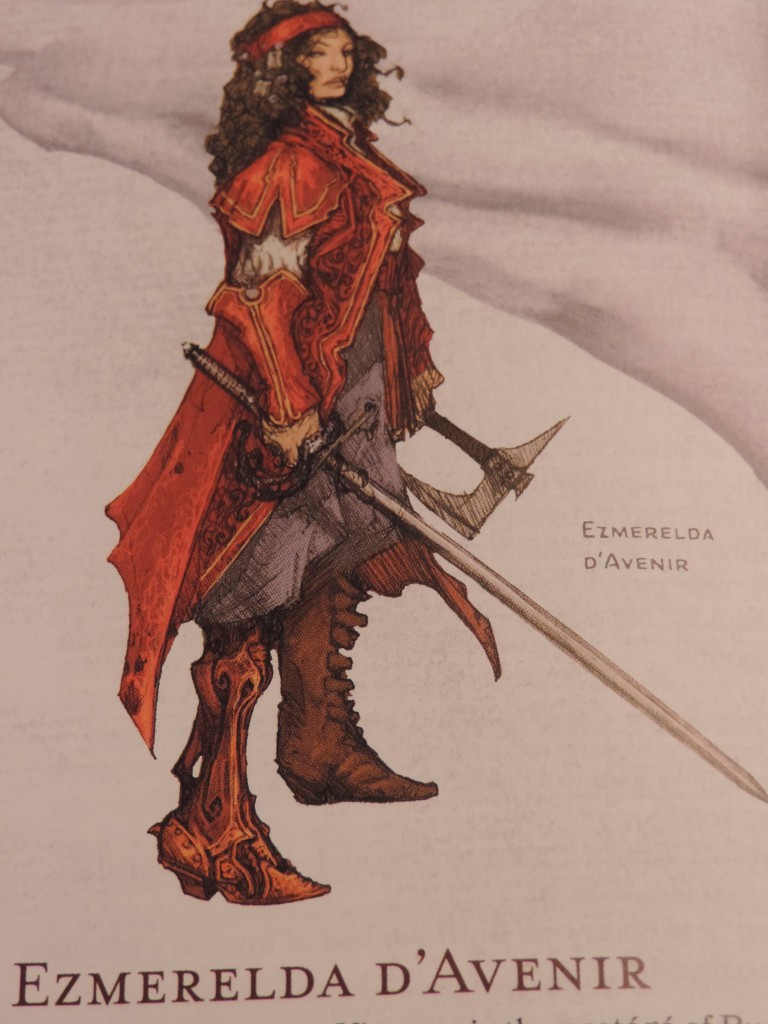
Perhaps one of the more interesting disabled NPC’s is Ezmerelda, found again in Curse of Strahd. Like her evil counterpart Izek, Ezmerelda is missing a foot from a wolf attack (a common occurrence in Ravenloft). What is curious about Ezmerelda’s representation is the disparity between her visual portrayal and her narrative background. In the drawing of her, we see a strong, defiant woman standing with her mechanical boot in the foreground. In the biographical information about her, we learn that “she commissioned a master artisan to craft a prosthetic lower leg and foot. After several tries, he delivered a prosthesis that restored her mobility. She has since adapted well to the false appendage and takes care to hide it from view.”19 So we are seeing a disconnect between the story of Ezmerelda and her visual representation. We receive mixed messages about her disability and how she feels about it (and therefore how we, the potential fellow adventurer, and/or DM should feel about her disability). Though she is not an evil character, nor is she portrayed as a supercrip, her disability is negatively and ambiguously portrayed by the text as we try to navigate the disparity between the visual representation and the rhetorical description.
And there are many other NPCs out there, either represented as evil, a supercrip, or ashamed of their disability and therefore hiding it (e.g. Quinn, a neutral good ranger from Storm King’s Thunder who is missing an ear, but “prefers to talk about the part of the story where he cracked open the barbarian’s skull with a rock”20; Kasimir, also missing his ears, from Curse of Strahd has a neutral alignment, but “wears a cowl to conceal his mutilation”21 emphasizing the need to hide his disability, etc.). Sadly, there are no positive models in the source material and without any possible positive representation of disabled characters, one cannot inspire or encourage players to create their own disabled characters and/or treat disabled characters (people) with respect. NPCs who embrace their disability as part of their identity would be much more welcome as a model, a pathway, for player characters to empathize with and emulate.
Visual Representation of Characters in Source Material
Of all of the illustrations from the PHB which specifically focus in on characters, none of them showcase any kind of physical disability. Similarly, in the Dungeon Master’s Guide, out of all of the illustrations, only three images potentially highlight a possibly disabled character:
-
A character starting the petrification process with a medusa in the background.22
-
A character looking rather green and desperately clinging to someone (presumably a healer) above her showcased in the “Diseases” section (emphasizes being needy, helpless, victimized; subject to the help of someone else)23
-
A character being healed (slashes and gashes in the skin, bandage around the head, medical bandage on the eye) – wounds about to be healed by the elf behind him holding ointment and a cloth – clearly intended to be “fixed”24
These images of non-able-bodied characters were mainly portrayed in sections related to the ludology (or game mechanics) of healing a player character. The two illustrations that include a healer in the background establish a visual hierarchy of healthy/healer above with disabled/victim below.
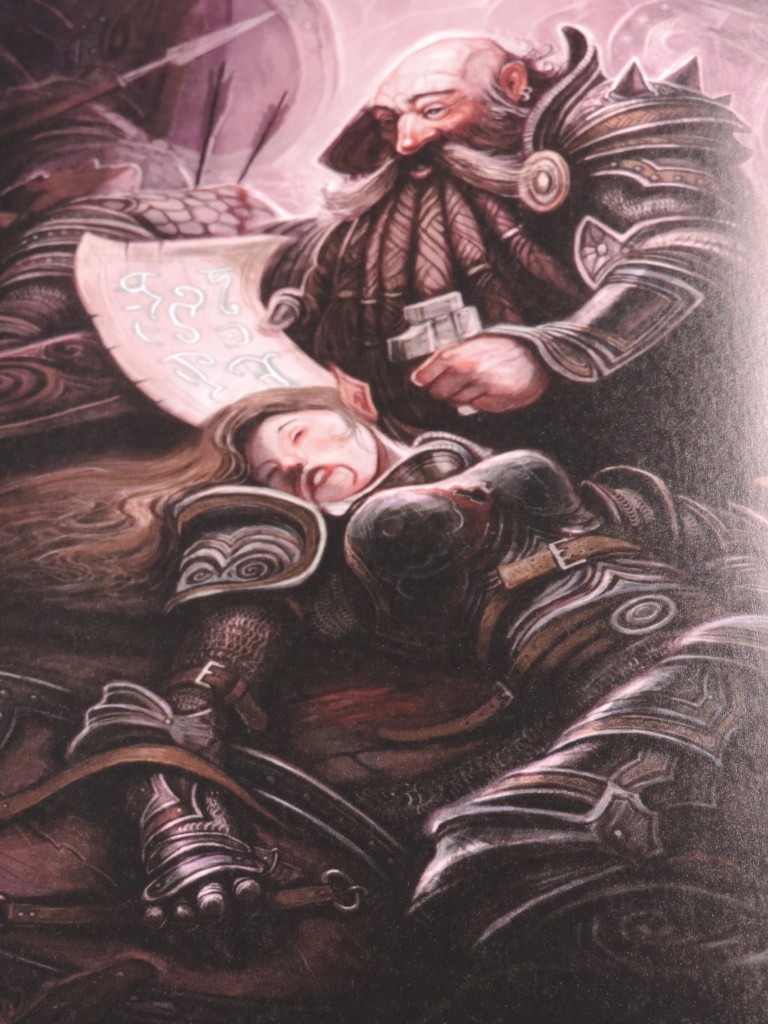

Once again, the focus is able-istic in that they suggest these are undesirable conditions, conditions to avoid. Of course: no one wants to be petrified into stone or poisoned either. However, it would have been nice to have seen a disabled character in the PHB or DMG that is not trying to magically heal away their disabilities: a badass monk with an artificial leg, a one-eyed half-orc battling an owlbear, even a gnome tinkerer with a vision impairment who needs glasses would have felt more inclusive.
While it is important to remember that disabilities may not be visually apparent (e.g., someone suffering from depression may not show visible signs; there are no physical markers of someone with a learning disability the way there is for someone who is an amputee), having some representation of characters with disabilities is important. If the relatively easy task of representing easily visually-identifiable disabilities has not been accomplished, one could hardly expect a fair portrayal of characters with less “obvious” disabilities either.25
5e Inclusivity for Gender & Sexuality versus Disability
A friend of mine once told me: “They give you three pages on how to play a cat person, but no guidance on how you might play a disabled character, something I am in real life.” Indeed, Wizards of the Coast does not give one that much guidance on role-playing other aspects of a character when it received enormous praise for making the game more inclusive. The 5e Player’s Handbook has been touted as encouraging gender and sexuality inclusion based on a few sentences as well as more diverse pictorial representation such as images of a dark-skinned human female26 or an androgynous magic user.27 This statement was added to encourage inclusion: “You don’t need to be confined to binary notions of sex and gender. {…} You could also play a female character who presents herself as a man, a man who feels trapped in a female body, or a bearded female dwarf who hates being mistaken for a male. Likewise, your character’s sexual orientation is for you to decide.”28 Recently, Wizards of the Coast has come out to say that they are committed to having more LGBTQ NPCs in their modules and have ensured this kind of inclusive representation.29 This support and inclusivity for gender and sexual diversity is to be applauded and stands as a significant development in the gaming industry. But one should contrast that with its games perspective on disability and bodily diversity. Listed under “Other Physical Characteristics” in the PHB, it states: “To add a touch of distinctiveness, you might want to give your character an unusual or memorable physical characteristic, such as a scar, a limp, or a tattoo.”30 In this example, a physical trauma, an ambulatory disability, and a (probably voluntary) skin marking are being equated. Furthermore, these are being treated as an afterthought, a narrative element, something to simply distinguish your character from all the other wizards out there. How are your wizard’s tattoo and my barbarian’s limp equivalent? In his article “Access to the Page: Queer and Disabled Characters in Dungeons and Dragons,” Michael Stokes takes a historical approach, examining how gender, sexuality and some disabilities were treated in previous editions.31 While Stokes well-observedly points out that, in 5e, the background of soldier class quite blatantly describes PTSD, this example strikes me as token and stereotypical. This is a narrative-driven element which may inform the way a player might role-play her character, but is reductive and cliché at best.
What to Do?
Another important aspect of disability awareness is how to make the game itself more physically accessible to players who have disabilities. Key steps are being taken to help solve the physical accessibility of the game: for example, 3D printing Braille dice for blind players, using programs like Roll20 to enlarge maps for visually impaired players, etc. This is an important step in embracing disability, but it is not the only way forward. In her article “Dungeons, Dragons, & Disabilities” in Dragon + Magazine, an official D&D outlet, Elsa Henry discusses inclusionary practices for accommodating disabled players at the table. As part of Henry’s article, there is a “Top Tips for D&D Inclusions.” This list is visually separate in the article in a box, making it unclear if this is still written by Henry or Wizards of the Coast itself.32 Many of these tips focus on making physical accommodations for players with disabilities in order to provide them with access to the game itself.33 Another tip states “Acknowledge disabilities as a part of the world of Dungeons & Dragons rather than using it as flavor text to make NPCs creepy or funny,” but incorporating disability as flavor text is exactly what we are told to do in the PHB to have a “memorable feature like a scar, limp, or tattoo.”34 Further, the article recommends to “assume that injuries could impact characters in the long term during a campaign”. This could be achieved by incorporating the optional “Lingering Injuries Table” located in the DMG.
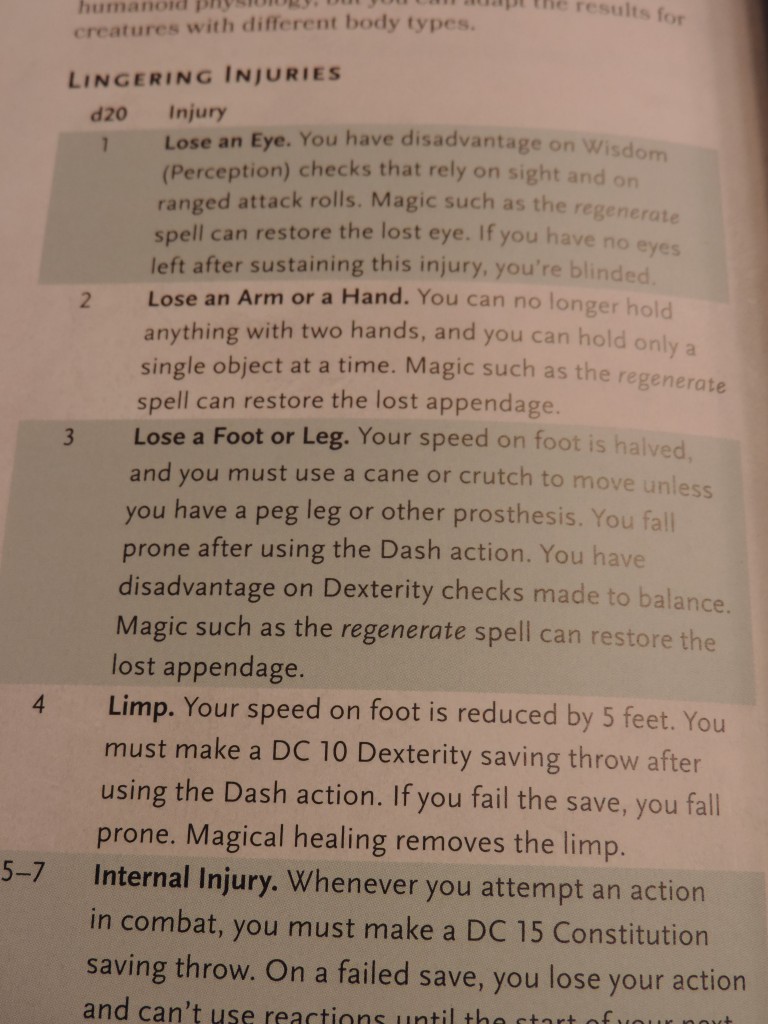
However, this table feels as punitive as the madness table as it is based off of the DM’s discretion, thereby taking the agency away from the player with regard to specifically building a character with a disability. Once more, as with most conditions in D&D, these injuries may be magically healed, which reiterates the ableist medical model of disabilities that suggests that a disability is a negative condition, something to be avoided and “subjected” to. In addition, we see an inequality between the severity of these injuries: from the loss of an eye to a minor scar. Another suggestion from the Dragon+ article is to “include disabilities as options for new characters for roleplaying experience,” which is a wonderful idea, but with neither discussion nor representative guidance to support it.
One might ask if the optimal solution were something more mechanics-driven, something that goes to the opposite extreme in approach. That is not my suggestion. Systems that reify disability into mere numbers do not help either. Point-based systems, for example, reduce the dimensions of a character’s deafness to a -5 penalty on perception. In her article “Reimagining Disability in Role-Playing Games” Elsa Henry discusses her first experience with a point-based disability model:
When I was creating my first character, I saw listed next to things like ‘wrathful’ and ‘alcoholic,’ the word ‘blind.’ Blindness here was reduced to a flat five point negative. I was blind, but I didn’t feel like it was a flaw, I felt like it was just a part of who I was. Blindness is not the only ‘flaw’ available for players to take. Interested players are offered a veritable buffet of ‘flaws’ to choose from. Does placing point values on disability really help players to understand how to best perform disability in a game?35
Disabilities should not only be portrayed as flaws, reductions to one’s ability checks, but these disabilities should not be inherently absent from the game either. Neither should they be merely an interesting narrative tidbit that has no actual bearing on the character.
In her own work on making D&D more accessible to players, Henry offers some examples of how disabilities might be incorporated into a character more robustly as opposed to simply a narrative element or a penalizing mechanical flaw: “A blind warrior might use a staff rather than a sword, pointy on one end and ready to destroy enemies at the first sound of danger. A character with a prosthetic arm or leg is less likely to succumb to the bite of a poisonous creature, because, of course, that limb is immune.”36 These are creative and inclusive suggestions for players that should be encouraged, but these ideas need to be modeled and represented in the source material as well. Henry encourages players “to step outside your comfort zone and give it a shot,” but it should not be only the player’s onus to do so. Players should not have to take full responsibility to come up with these role-playing adjustments on their own. Asking disabled players to commit more time and energy into creating their characters without structural support from the source material is a significant challenge, particularly considering issues of balancing game mechanics and ensuring parity among characters. Rather, in order to discourage ableism, Wizards of the Coast should represent and model the different possibilities of character, as opposed to simply putting this kind of home-brewing on the responsibility of the player.
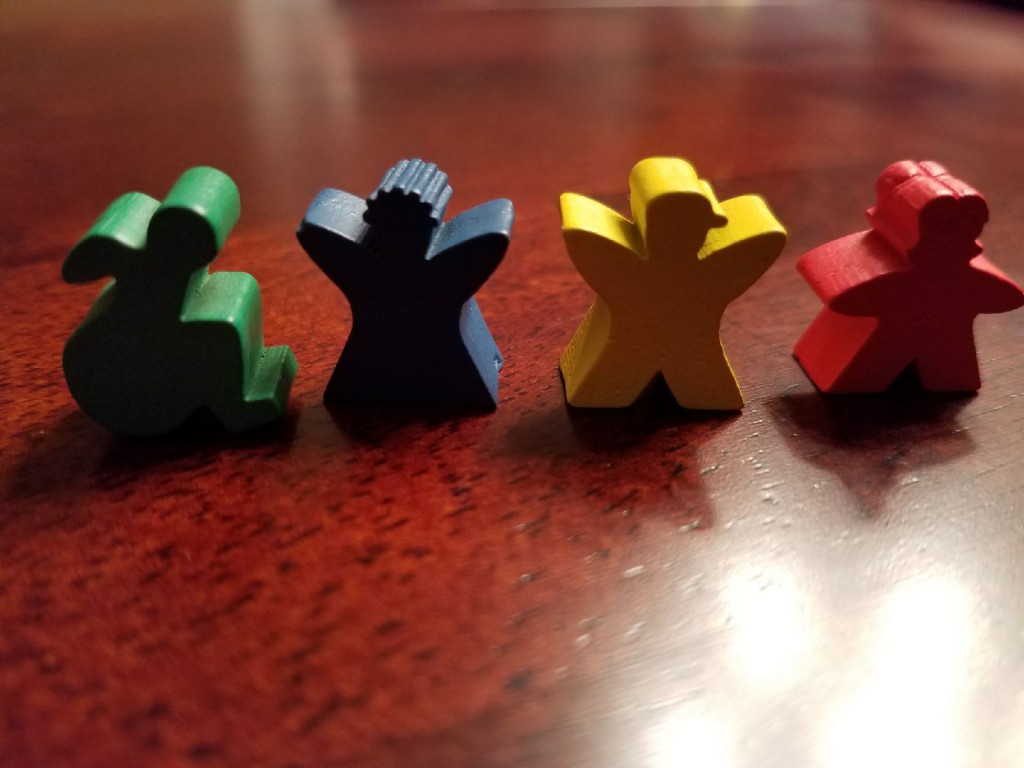
Conclusion
D&D 5e has made wonderful strides toward making their product and gaming gestalt more inclusive. But for a game that relishes offering insights on the stats, history, lore, and quirks of multiple races and classes of characters (not to mention their economy, religion, societal norms, temperament, and passions), the game is silent on any possibility of being not 100% able-bodied. The same inclusive, open principles that they provided to other underrepresented players should be applied to disabled gamers and characters. Unfortunately, there is no ready-made, easy solution to this problem. But more sensitive treatment of disability, or even an awareness of these issues brought to the gaming table, would be a welcome start. Dungeons and Dragons among many other RPGs must reconsider how they portray disabilities and subtly promote ableism throughout their source materials. More thorough treatment, consideration, and inclusion of disabilities in D&D should replace their hitherto static, stereotypical portrayal.
—
Featured image “Owlbear” by Joseph Wu CC-BY Flickr
—
Shelly Jones, PhD is an Assistant Professor of English at SUNY Delhi, where she teaches classes in mythology, literature, and rhetoric. She received her PhD in Comparative Literature from SUNY Binghamton. Outside of academia she is an active nerd who enjoys board games, Dungeons and Dragons, being outdoorsy, and knitting.


Great article! This is one of the reasons I prefer the GURPS system over DND – you are able to give your player character specific disabilities, like blindness, paranoia, or varying degrees of deafness as examples, and when you take one, you get more points to create a stronger character. It encourages creating characters with disabilities who are stronger in other areas and I find it gives me a lot more room to make unique and interesting PCs – all without having to create my own rules to handle it.
One thing to keep in mind when discussing D&D is that it tries to support two different types of gameplay (and more, probably, but two are relevant); first is the telling of fantasy stories, and the second is the one where players are striving to have their characters succeed in adventurous tasks.
For a game of drama or telling stories, there is little reason to not include disabilities, and no problems for including them. Burning wheel is an example of a game that does this reasonably well, I guess; one can buy various features for one’s character, and some disabilities are there side-by-side with other traits. A trait that affects play gives meta-level currency to the player, which they can use to succeed at rolls and eventually improve their character. Dungeon world would be another game where disabilities would be easy to introduce, as many disabilities do not prevent fantasy action set pieces. I do not know if Dungeon world addresses disabilities in any way; I do not remember anything in the rules, but maybe the art contains something?
In games where players try to have their characters succeed, as a primary goal of play, disabilities are more difficult to handle. Many disabilities make adventuring significantly more difficult. If one wants to keep a level playing field among characters, either all of them have to be disabled in equally challenging ways, or there must be some trade-off (GURPS-style points, or receiving an extra feat for a flaw, etc.).
Some such games do not assume a level playing field among players characters, and in such games players may indeed voluntarily play a disabled character, much like someone may choose to play a beggar when a knight would also be a possible character to play (and superior in most, though not all adventures).
Many OSR (old school revival) groups do use rules for permanent or semi-permanent wounds, should character survive the situation where they receive the wounds. Some examples: https://deathanddismemberment.blogspot.dk/2014/11/d-on-death-dismemberment-tables.html
Unfortunately, modern D&D is among games which do assume roughly equally capable player characters, and which does try to cater to players playing to succeed. As such, introducing disabilities for it is an interesting design challenge.
I have to admit, I am really not sure where to begin in the unpacking of this article. I suppose first would be to say that, while it’s purely conjecture, I suspect the author has no physical disability, and that she has never actually played the game, and I don’t intend either of these suppositions to be accusations.
The objective of role playing games is not, generally, to “create a character that reflects their own identity and reality.” I have, myself, played characters with a number of disabilities, both physical and mental, and I know many other players who can say the same. The mechanics of this, and most, role playing games makes this entirely within the realm of possibility, and there is little if anything discouraging players from doing so if they choose.
The author addresses the artwork as if it were portraying negative stereotypes, but seems to have projected her own preconceptions upon them: The “old man” she points to is in fact a gnome, and doesn’t appear to be terribly old, and the dwarf who has been “blinded” is in fact, *wearing a blindfold* and therefore, by definition, blinded. Not *blind*, necessarily.
And since she asks that the game be more visually inclusive, I’m curious what imagery she would choose, to represent someone who simply cannot hear, or someone who simply cannot see? Given that neither condition has an inherent visible attribute, she can only be assuming that all the colorful characters in other illustrations who do not have blindfolds or ear-horns are in fact, not in any way disabled.
Merely some personal observations, and no disrespect to either the author, nor anyone with any sort of disability.
As a physician who has been playing D&D for about 40 years I found your article to have some valid points that Wizards should address. I agree that the artwork mentioned is offensive and demeaning. I agree that there should be better mechanics to portray characters with disabilities and allow a player with disabilities to embrace rather than abandon an important aspect of their identity. Take the analogy of a player who, in their real existence, is physically weak. That player has the option to create his character in different ways. One is to could create an ultra strong fighter-type to explore what they could never actually do. Alternatively they could play a character who’s strength has little bearing on what they can achieve. Characters with disabilities should have similar options. Until these are available it is up to the DM to work with players to find ways to portray their desired character without disrupting game play.
Back in the early 80’s a members of our gaming group was paraplegic. It is interesting, in retrospect, that none of us (all intelligent and socially aware) ever brought up the idea of playing a character with a disability. I don’t remember even considering the possibility. It shows that conversations like this are long overdue.
That said, my current character is a blind bard with multiple personality disorder. I have to confess that 3 of the 5 members of our gaming group have been playing together for about 20 years, so we are not a typical group. We are also well accustomed to creating very atypical characters. Role playing is more important to us than having the most powerful party.
There are existing ways to help compensate for disabilities and ways to role play around some of them, especially with the DM’s assistance. Deafness need not be overly limiting to a party. Other members can listen for dangers the character might have missed. Players can communicate with sign language or acquire a means for telepathy. A player lacking a limb can compensate for in may ways. Even complete paraplegia can be compensated for, especially if the player is willing to play a character relying primarily on mental attributes. The difficulty of mental illness will always be more of a role playing problem than one of game mechanics. Blindness poses some unique difficulties and I do not advise it for a beginning gaming group as I think it would add stresses that they do not have the experience to easily handle.
My DM gave me a bonus on perception checks for hearing and smell and touch, all of which provide a benefit to my party. With a character such as a bard you can concentrate on a primarily supporting role and still aid the party while accurately portraying the disability. Playing a blind front line fighter type is more difficult. OK, my bard does that too, but it took a lot of thought and time working with the DM.
There are also some game mechanics to help overcome some of the drawbacks of disabilities. Spells can be used to take away an enemy’s sight (or hearing or movement, etc) and turn the tables to give advantage to the character accustomed to their condition. Spells and magic items can be used to remove some of the hindrances the disability poses, just like technology does in the real world. To argue that this should not be necessary is like arguing that people with actual disabilities should not take advantage of technological aids that are available. Using a familiar (available to any character fairly early in the game) for periods of vision is helpful, though there are limitations to this. There is no reason you cannot have a trained companion animal that acts as service animal or even have your familiar play that role. These are only a few examples.
In the end an experienced DM should be able to work with players to create and play a character with disabilities. Wizards should continue to strive to be more socially responsible. Removing offensive artwork is an easy first step.
Tackling societal apathy and prejudices will be more difficult.